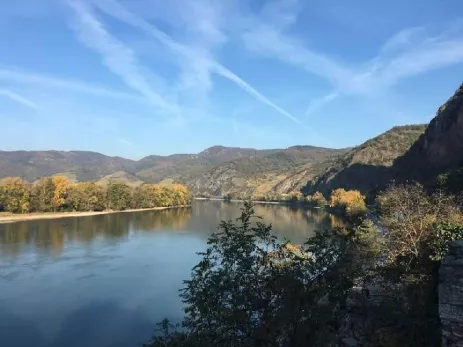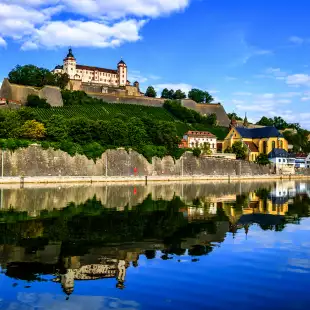The History of the Danube

Discover the history of one of Europe’s most famous waterways.
With a length of 2850 km, the Danube river is Europe's second longest river, after the Volga, more than twice as long as the Rhine and over three times longer than the Rhone. Starting in Germany, in the Black Forest, there are 10 countries on the Danube, and it passes through four capital cities until it reaches the Black Sea.
Throughout history, waterways have been the cheapest and easiest means of transporting people and goods. The Danube is one of the world’s most famous rivers, standing alongside the likes of the Nile, the Yangtze, and the Mississippi as places of natural beauty and the epicentre of history and culture.

The Danube in Roman times
The Ancient Greeks navigated up the river Danube from the Black Sea as far as the Iron Gate, in search of trading partners. However, river transport was further developed by the Romans.
During Roman times the Danube, or Danuvius as they called it, was patrolled by the Roman fleet and used as a route of transport for soldiers and supplies. Settlements formed around military outposts on the riverbanks and slowly became the cities we know today, including Vienna, Belgrade and Ruse.
Roman troops also occupied the Celtic settlement named Aquincum, or ‘abundant in water’. Having already developed a sophisticated bathing culture at home, the Roman settlers built bathhouses here after discovering its natural thermal waters. This settlement is now known as Budapest, and bathhouses are still prominent in the city today.

The river Danube formed part of the northernmost boundary of the Roman Empire, protecting the crumbling Roman Empire from barbarian invaders from the steppe lands of Ukraine and Central Asia. However, their hold over the Danube ended following invasions of Avars and Slavs in the early 7th century.
The Danube in medieval times
During the medieval period, the river was an important source of food. It’s one of the most highly biodiverse habitats in Europe, home to hundreds of varieties of fish, including salmon, trout, sturgeon, and carp, many species of which are not found elsewhere.
After the fall of the Roman Empire, castles and fortresses were built along the Danube by Charlemagne and other rulers, many of which you can still spot on a cruise along the river. Find out more about the castles along the Danube on our blog 10 of the Best Castles on the Danube.

The Ottoman Empire
The Danube was 'the river where the fate of the Ottoman Empire was decided' (Franz Babinger). Once one of the most powerful states in the world, during the 15th century, the Ottoman Empire spread from southeast to central Europe, gaining control of the Danube to become its northern border. In later centuries this border led to disputes with the neighbouring Kingdom of Hungary and other nations further upriver, and many of the battles in the Ottoman-Hungarian wars (1366 - 1526) and Ottoman-Habsbury wars (1526 - 1791) were fought along the Danube. This separation between East and West would come to define the story of the river for centuries to come.
This trade corridor along the river Danube gave rise to two major empires, Austrian and Hungarian, which merged under Austria to become the Austro-Hungarian Empire in 1867.
Downstream, the lower Danube formed the boundary between Romania and Bulgaria. The flood-prone plains allowed for a significant cultural boundary between the two regions, even now, they have distinct differences, with Bulgaria showcasing significantly more Ottoman influences.
The Danube River modern times
Trade in the 19th century
The Danube became more important as a waterway for shipping and trade in the 19th century, as the fishing industry rapidly declined. Shipping faced new challenges, as the river can be an unpredictable and dangerous place to navigate, with ice flows, fast-flowing narrow passages, and an endless number of submerged rocks and small islands. This led to the creation of several locks to calm certain stretches and make them more accommodating for large ships.
The construction along the river allowed it to become a lifeline that has fuelled the prosperity of many cities and countries along it, especially Hungary, which covers a third of its total length. The Hungarian capital, Budapest, is often called the Queen of the Danube, with its famous chain bridge, castle, and gothic parliament building.

The river also flows through Vienna. In the 19th century, the city had built a reputation as the city of music, adding to the history and culture of the river. The city, through which the Danube flows, inspired many composers including Ludwig Van Beethoven, Franz Schubert and Johann Strauss, who famously wrote The Blue Danube, after which our river cruise is named.
View our Blue Danube river cruise
The 20th century
Though the Ottoman Empire lasted for 600 years, it gradually succumbed to decline after fighting on the side of Germany in World War I. Due to the upheaval of World War II and other wars, and the formation of the European Union, the Danube region saw numerous changes across the decades.
Close by, Nuremberg was an important site during WWII, hosting the Nazi Rallies, and, after the war, the Nuremberg Trials. The Nazis took control of the Danube by force through the annexation of Austria, the invasion of Yugoslavia and the Soviet Union and treaties with the Kingdom of Romania and Hungary. There are hundreds of vessels scuttled along the Danube and revealed during droughts.
The 21st century
At the end of the 20th century, a series of canals were completed connecting the Rhine, Main, and Danube rivers. The waterway staircase measured 171 km long, allowing ships to sail from the Black Sea to the North Sea via European rivers.
We cruise along the Main–Danube Canal on our Cruise the Heart of Europe river cruise.

Today, the Danube is a busy waterway both for shipping and pleasure craft, with ships able to navigate from the Black Sea to Rotterdam via the canal connecting the Danube to the Rhine. The diversity of landscapes, countries, and cities along its route still makes it irresistible for European river cruise holidays, offering a fascinating journey through the heart of the continent.
Find out more about travelling on the Danube with our travel guide.














